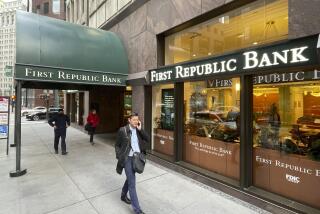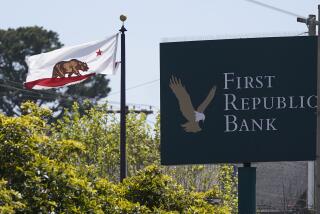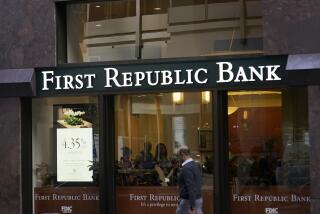Banking Industry Proposes U.S. Takeover of Sick S
- Share via
WASHINGTON — Alarmed that banks might have to pay some of the cost of rescuing failing savings and loan associations, the banking industry called Tuesday for a federal takeover of hundreds of sick thrifts by a new government corporation to be funded by as much as $100 billion in tax revenues.
The American Bankers Assn., warning of national “financial instability,” took the extraordinary step of advocating the nationalization of a significant portion of a major rival in the financial field. Challenging the basic purpose of the S&L; industry, the ABA said Congress should reconsider the need for a “specialized housing credit system.”
The persistent fiscal drain created by ailing S&Ls; is “everyone’s problem because the thrift crisis poses a (Hurricane) Gilbert-like threat to the entire U.S. financial system--especially healthy thrifts and banks,” Donald Ogilvie, executive vice president of the ABA, told reporters at a news conference.
Banks are already paying extra to attract deposits because ailing savings institutions are offering premium interest rates to woo savings.
And the bankers are particularly eager to avoid bearing any of the financial burden of rescuing the thrifts. Banks now pay only $83.33 a year for federal insurance for a deposit of $100,000, the maximum protected under the law, while S&Ls; pay $208.33.
The bankers are disturbed by suggestions that the federal insurance funds for banks and S&Ls; be combined, said William T. McConnell, president of the Park National Bank of Newark, Ohio, and chairman of the special ABA committee on the S&L; crisis.
Ogilvie said the banking industry’s top priority in Congress next year would be legislation to make taxpayers, and not the commercial banking industry, bear the costs of rescuing the thrifts.
Commercial banks, regulated by the Federal Deposit Insurance Corp., the Federal Reserve Board and the Comptroller of the Currency, offer a wide range of financial services, with loans to both individuals and businesses. S&Ls;, on the other hand, regulated by the Federal Home Loan Bank Board, have a specialized purpose--to provide home loans.
Draws Cool Reaction
The ABA proposal drew a cool reaction from federal regulators and an angry response from the S&L; industry itself. The proposal is certain to get a skeptical reception in Congress, which is already operating under the constraints of a big federal budget deficit.
“There’s a lot of strong feelings against any bailout,” a knowledgeable congressional aide said Tuesday.
The bank board stuck to its insistence that the fees it collects from healthy S&Ls; will be sufficient to deal with the sick ones.
The call for a new government agency “sounds like a rather last-ditch idea, a last resort type of thing,” said bank board spokesman William Fulwider. The agency, he said, does not share the bankers’ dramatic pessimism. “In the short run, we feel we have the resources to deal with the problem,” he said.
The U.S. League of Savings Institutions, a trade group, objecting strenuously to the bankers’ proposals, declared: “We . . . take sharp issue with the ABA’s suggestion that one of the ways to respond to the problem is to do away with specialized institutions and the Federal Home Loan Bank system.
Says Role Still Valid
“Savings institutions fulfill this country’s centuries-old commitment to homeownership opportunity, and their importance in that role today should not be lost in the search for solutions to the problems of the deposit insurance agencies.”
The ABA, in warning of the future costs of rescuing ailing S&Ls;, argued that at least $74 billion would be needed to close or otherwise dispose of the thrifts already classified as insolvent because their liabilities exceed their assets. Other institutions that may become insolvent later could bring the price tag to $100 billion, it said.
The bank board, by contrast, says the cost of shutting, merging or selling the insolvent institutions will be $30.9 billion, far less than the $42 billion the bank board expects to earn in the next 10 years through the premiums it collects from healthy thrift institutions.
And even the congressional General Accounting Office, which recently upped the ante, put the price tag at $45 billion to $55 billion.
Government Corporation
The ABA said the only way to handle a $100-billion bailout would be with a government corporation funded by the taxpayers. The bankers group offered no details on how long the agency would be in existence or whether the $100 billion should be raised quickly or in stages. The corporation would take over the crippled S&Ls;, shut down the weakest of them, pay off depositors and hold the real estate and other assets for later sales.
ABA officials carefully avoided words such as “nationalization” or “federal takeover,” instead calling the proposed agency a “limited-life liquidation trust.”
But it would create a giant federal savings and loan agency, the owner of 511 insolvent thrifts nationwide in which liabilities exceed assets. The ranks could grow by another 150 institutions.
More to Read
Inside the business of entertainment
The Wide Shot brings you news, analysis and insights on everything from streaming wars to production — and what it all means for the future.
You may occasionally receive promotional content from the Los Angeles Times.










